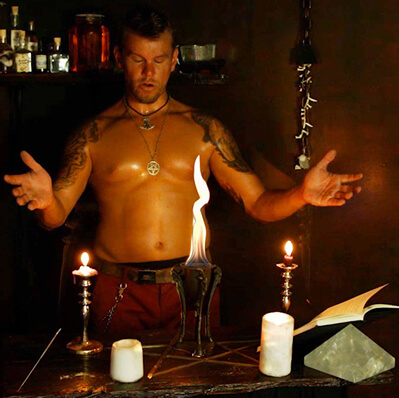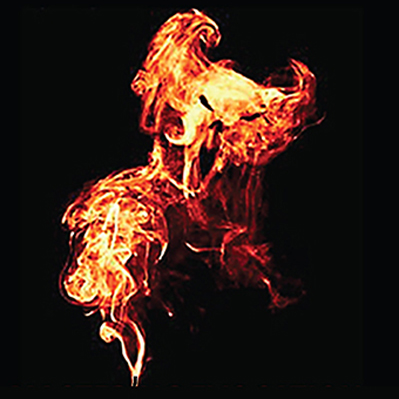Full Transcription
Hello everyone, Bill Duvendack here with another power point presentation video for the upcoming Ancient Egyptian Magick video series being released with Become a Living God. Today I wanted to focus on some of the lesser known deities that exist within the Egyptian pantheon to give you an idea of how wide ranging the material is in the class and what you can get out of it.
Now there is something you should know ahead of time, and that is that I handpicked the deities to focus on because they're lesser known, and they have traits and characteristic that are more in line with Draconian Magic, The Left-Hand Path, and really the Become a Living God crowd in general. Having said that, let's have some fun looking at the gods.
Let's start off with some of the lesser known gods. A lot of times people emphasize the cult of Osiris and the rise of the Pharaohs and the solar deities, whether gods or goddesses, but there was a whole facet to the ancient Egyptian pantheon that really kind of gets glossed over.
So let's start by talking about Am-Heh. Some you may recognized the title "Devourer of Millions," because it is also used for part of the weighing of the soul process in the Hall of Amenti and corresponds to a different deity. But Am-Heh is actually a little bit older, so it's believed that characteristics of Am-heh got added into Amit later on. The traditional Am-Heh is a man with a hunting dog head, so you can see that the image vastly difference from what we know to be associated with the "Devourer of Millions."
Also I've noticed the fact that Am-Heh is controlled by a tomb, the hidden one, so in that way it's almost like the Devourer of Millions coming out of the darkness, or coming out of the hidden into the light.
Another deity that I want to address here is one of my personal favorites, Denwen. Denwen is known as the Fire Serpent. For those of you that are familiar with Chakras and the Kundalini, and the energetic body of a person that we have from Hinduism, probably recognized the title the Fire Serpent from Sir John Woodruf's book in the latter part of the 19th century that really kind of laid the foundation for a more in depth study of Kundalini.
However, when you do your research, you find out that Kundalini, specifically the Fire Serpent connotation to it did not occur until approximately the 15th century. Denwen was around a lot earlier than that. So one of the takeaways from this is we can say that a case could be made for the fact that the Fire Serpent concept actually comes from ancient Egypt, not Hinduism.
Now of course you could make the argument that it came from Hinduism if you believe in the revealed teachings and the hidden information about how old Hinduism really is. But a third argument that could be made is simply that Hinduism and the ancient Egyptian cosmology developed at the same time, and therefore one influenced another. So while this particular being as the Fire Serpent does not 100% correlate to Kundalini, we could easily say that you could work with Denwen to work with the Kundalini, and since we know that ancient India and ancient Egypt traded extensively with each other, we could say that this influenced Hinduism, or that Hinduism influenced this.
However you look at it, I really appreciate the fact that what we're talking about here is the same concept as the Fire Serpent, and it exists in multiple pantheons.
Now we move our attention to Mafdet, and when I was researching this, I actually came across some conflicting information. Mafdet I've got listed here as a god, but as many references as I saw to Mafdet being a god, I saw just as many to Mafdet being a goddess. However, what I appreciate about Mafdet is that it's the netter of justice, and the executioner of criminals.
So for those of you out there that are seeking justice in some for or another in your life and you're drawn to the Egyptian Pantheon, you may want to consider working with Mafdet.
The next one to look at is Mahes, which is known as the god of massacres and mass slaughter. It is entirely possible that the Mahes we're talking about here is the same as Maahes, which is talked about in the video course, and I mentioned that because oftentimes when scholars are translating hieroglyphs, they can have differences of perspective as how to interpret that hieroglyph. Here we have this particular instance.
On one hand, Mahes is the god of massacre and mass slaughter, Maahes is a lion-headed god of war, child of Ra and Bast. So you can see how the two cross over. It's entirely possible that they're the same entity or that they are closely related entities. While this may seem like an exception or something that's different, the fact of the matter is you see this quite a bit, not only in ancient Egypt, but in other ancient cultures as well, such as Mesopotamia where the deities evolved and changed over time, sometimes they connected with the dynasties that were coming into power. Other times they were supplanted by the dynasties coming into power.
We now turn our attention to Onuris which is another god of war. And I simply put Onuris on here because it shows that while war is a singular subject, often times the ancient Egyptians had several different deities that corresponded with war. This is present for a variety of reasons. On one hand you may have a city like Heliopolis have a god of war, and then a different city like Thebes have an entirely different god of war at the same time. Now, another way to look at it is that each one of those war deities focus on a different facet of war, so that's something else to consider as well.
We now move to Shesmu, and you know I put Shesmu in here just for fun. Shesmu is a god of wine and perfumes, however, Shesmu is also the god of executions, slaughter, and blood. So next time you raise a glass in a toast with wine or you anoint yourself with perfumes, feel free to call on Shesmu if you really want to do some executions, if you really want to slaughter your enemies, even if they are your own internal demons. And if you're working with blood, feel free to call on Shesmu in that context as well.
Now that last line, sometimes referred to as a demon, may seem like a detail, but it's actually very important to know. In the ancient Egyptian pantheon, the idea of demons, or what we commonly know as demons today was not used extensively. The reason for this is because the ancient Egyptians believed that the deities were the personification of the forces of nature, so how can you have a demonic force of nature? I share that just to give you some food for thought when you're going through the second video course with the gods and the goddesses, you may want to read between the lines of what I say and see that the idea of angelic or demonic, maybe they're in a hidden fashion, but you generally don't see it on the surface quite a bit like with have with Shesmu.
Finally, even though it's solar-phallic and Pharaonic, I want to take a moment to talk about the 12 Semi-Divine Sons of Horus. The myth says that this is a lineage of leaders said to rule before the Pharaohs. Now let's put this in context, because I put a lot of emphasis in the video class on Draconian Egypt, which is what was Predynastic and exists before the rise of the Pharaohs.
So the question that I asked myself when I was putting this in here is how does this connect with Draconian Egypt? I mean if these 12 Semi-Divine son's of Horus were said to rule before the Pharaohs, then wouldn't that make them ruling at the same time as Draconian Egypt? The short answer is these 12 Semi-Divine Sons of Horus would have came about in between the Draconian era of Egypt and the Pharaonic era.
So in that way they would be a bridge, and when we look at it that way, it makes a lot of sense because the timeline that we are left with is the Draconian Egypt, which would be the early days of Predynastic times. Then a transition occurred, and during that transition, 12 Semi-Divine Sons of Horus came into being and eventually that era ended with a shift to the Pharaohs.
I know it's a little bit tricky, but it's like a three part history when we really broaden our minds. Now, the fact of the matter also is that there's no archeological proof of 12 Semi-Divine Sons of Horus. This is myth and legend, but as you can tell from the name, it's based on the idea that Horus had sons with someone that was a mortal, and it gave them certain abilities and powers which that used, also as legend says, quite responsibly.
I realize this is a tour de force through the gods, but now let us turn our attention to the goddesses. The first one makes me smile quite a bit, it's Ahti, which is a spiteful goddess. Now I interpret this two ways. On one hand, the spiteful goddess means she's a goddess full of spite, so be careful when you deal with here. On the other hand, if you are feeling spiteful about something or someone, you may want to consider working with Ahti.
Now we move our attention back to another Draconian goddess, Athtor, which is a primordial night goddess and a goddess of the abyss. So those of you that work with the void and work with the abyss, you may find her as an excellent guide or an anchor of sorts as you move past [Corinzon's 00:11:53] trials through the abyss to come out through the other side.
We then have Hetep-Sekhus, an underworld goddess that is known as the Eye of the Flame." For those of you that are familiar with the Draconian tradition, you know a lot of times the "Eye of the Flame" corresponds to the dragon, but in this case we can see that it also corresponds to an ancient Egyptian goddess who is lesser known than the dragon. So if you want to work with Draconian entities and energies but you feel like connecting with the Egyptian side of things, here's your go-to goddess for that.
Then we have Khoemnu. On one hand, she's the personification of Egypt or Kam, the country itself. However, as you can see on the screen, she is also an underworld goddess of fire as well as an enchantress and a succubus. A lot of people don't stop to realize that the idea of incubi and succubi, and even vampires, was around in ancient Egypt, and although they went by different names and they were different concepts, as far as titles go, and they were worked with slightly different, the energetic archetype and template was still there. And here's one of the lesser known ones, yet if you work with succubi energy from an Egyptian perspective, she's really your go-to, and if she's not, than I can't really feel confident that you're working with Egypt.
We then turn our attention to Shait, and yes those of you that are familiar with British English are probably enjoying a good laugh, so, "Laugh it up fuzz ball," as the movie goes. Shait, or Shait, is the goddess of destiny. This is something that I really enjoy. She shows up at birth and shadows the individual throughout life. Then when it comes time for the judgment of the soul, she presents evidence to be evaluated at the point of psychostasia.
I really appreciate this, because there's been often times in my life when I have felt that I have been shadowed or followed by one being or another when I did nothing to incur an entity following me. And when you look into the Abrahamic faiths, they say things like, "Oh, you're being followed by God." Or, "Oh, that's your holy guardian angel following you and protecting you."
Well I'm not going to agree or disagree with those points. If that's what works for them, then so be it, but what I am gonna point out is that all Abrahamic faiths are descended from ancient Egypt, that has been factually proven time and again. So this idea of being shadowed by an entity would logically then come from ancient Egypt. So if you've ever felt followed, there's a good chance it was by the goddess of destiny who's recording your deeds and events, and when you die and your soul and your heart gets judged, it will be this same goddess who gives evidence, and the romantic in me says that I hope that evidence is good. But by that same token, if you've never done a lick of good of your life, then the evidence that is shown is not gonna be in your favor.
And finally, I just threw one on here for fun. Tenenet, the goddess of brewing and of beer. So no matter where you are on the planet tonight, if you are watching this or listening to this to unwind, then when you're done, if it is your will, raise a pint to Tenenet. Brace for the video class that's coming out the 26th. Then, as one of my favorite phrases goes, "Get back to work for the great work waits for no one."
I hope all of you have enjoyed this fun romp through lesser known deities of the Egyptian pantheon. Remember that the video serious comes out June 27th, which is next Tuesday, and for more information, you can go to balg.co/Egypt. Thank you all, and have a fantastic time.
 Egyptian Black Magick: The Essentials Every Sorcerer Needs To Know
Egyptian Black Magick: The Essentials Every Sorcerer Needs To Know Companion Workbook: Complete guide to Egyptian pantheon & more
Companion Workbook: Complete guide to Egyptian pantheon & more Author: Bill Duvendack
Author: Bill Duvendack Live: Midnight on June 26
Live: Midnight on June 26 Free Gift: Sign up now to receive Sabti Ritual eBook
Free Gift: Sign up now to receive Sabti Ritual eBook


